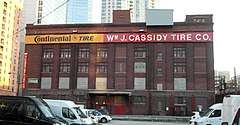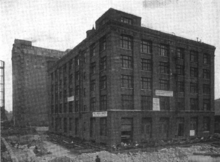Wm. J. Cassidy Tire Building
The Wm. J. Cassidy Tire Building is a building at 344 N. Canal Street, Chicago, Illinois. Designed by Henry J. Schlacks and constructed in 1902, it originally served as a factory and warehouse for the Tyler & Hippach Mirror Co.[4][1][5]
| Wm. J. Cassidy Tire Building | |
|---|---|
 | |

| |
| General information | |
| Architectural style | Chicago Commercial Style[1] |
| Location | 344 N. Canal Street, Chicago, Illinois |
| Coordinates | 41°53′17.8″N 87°38′25.2″W |
| Completed | 1902 |
| Technical details | |
| Floor count | 5 |
| Floor area | 100,000 sq ft (9,300 m2)[2][3] |
| Design and construction | |
| Architect | Henry J. Schlacks |
History

The building originally stood at 117–125 N. Clinton Street.[1] In 1907, it was sold to the Chicago and Northwestern Railroad.[6][2] In 1908, the building was moved 52 feet south and 168 feet east to its current location, in order to make way for the construction of the new Chicago and North Western Terminal, at a cost of $50,000.[4][1][7][8] The William Grace Company was contracted to perform the move, and hired Chicago engineer Harvey Sheeler, who had successfully moved several large buildings previously.[4][1][7] At the time, this was the largest building ever moved.[1]
In 1929, the Chicago and Northwestern Railroad began leasing the building to Producers Warehouse.[3] In 1947, the building was sold to the owner of Producers Warehouse for $75,000.[3] William J. Cassidy Tire & Auto Supply Co. purchased the building for $250,000 in 1970, and it became the headquarters of Cassidy Tire.[9][10]
In 2019, The Habitat Company signed a contract to purchase the property, and intends to demolish the building and build a 33 story apartment building on the site.[1][5][11] However, Preservation Chicago is working to have the building designated a Chicago Landmark and preserved as part of the residential development planned for the site.[1][4]
| Wikimedia Commons has media related to Wm. J. Cassidy Tire Building. |
References
- "Threatened: Cassidy Tire Building Endangered by New High-Rise Tower Proposal", Preservation Chicago. Retrieved November 30, 2019.
- Currey, Josiah Seymour (1918). Manufacturing and Wholesale Industries of Chicago. Volume 2. Thomas B. Poole Company. pp. 235-236. Retrieved December 2, 2019.
- "Railroad Sells Warehouse at 344 N. Canal St.", Chicago Tribune. October 5, 1947.
- Rodkin, Dennis. "What’s That Building? The Cassidy Tire Building — And Its Unusual Escape From Demolition", WBEZ. June 6, 2019. Retrieved November 30, 2019.
- Kozlarz, Jay. "Rendering reveals 33-story apartment tower replacing Cassidy Tire warehouse", Curbed. November 27, 2019. Retrieved November 30, 2019.
- The Economist. November 16, 1907. p. 769. Retrieved December 2, 2019.
- "Moving a Large Brick Building", The Engineering Record. Vol. 58, No. 12. September 19, 1908. pp. 317-318. Retrieved November 30, 2019.
- The Economist. June 13, 1908. p. 1063. Retrieved December 1, 2019.
- "Major Real Estate Sales Closed in 1970", Realty and Building. Volume 165. 1971. p. 122.
- Truini, Joe. "Chicago's Cassidy Tire Remains Family Owned After 103 Years", Tire Business. October 15, 1995. Retrieved December 2, 2019.
- Gallun, Alby. "Developer plans 33-story Fulton River District apartment tower", Crain's Chicago Business. May 09, 2019. Retrieved November 30, 2019.